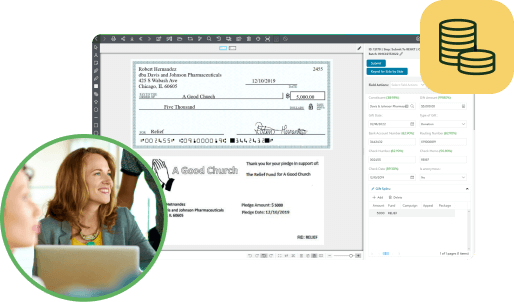Nonprofit leaders are essential to fundraising, but many organizations experience a disconnect between their top leaders and the on-the-ground fundraising staff members.
A recent donor insights survey found that many nonprofit professionals report a “significant gap” between how nonprofit CEOs and frontline fundraisers view their organizations’ performance. Research showed that these leaders tend to have a more positive perspective than staff. For example, 48% of CEOs think their organizations emphasize the wrong fundraising goals, compared to 80% of fundraising staff.
Consequently, we created this guide to help close this gap and foster more impactful leadership involvement in fundraising. Let’s explore five best practices for leaders to engage productively in the fundraising process.
1. Promote an open and transparent culture.
Facilitate a culture of transparency, accountability, and open communication with your full fundraising team. This will help close communication gaps and encourage fundraising staff members to speak openly and honestly about their challenges.
Establish an open culture from the top down by following these tips:
- Encourage asking questions. Give fundraising team members, especially new ones, avenues to ask questions. You can do this through a daily morning meeting, email, or your nonprofit’s internal communications tool.
- Promote transparency. Share data with your team that provides context for their fundraising efforts. For example, be transparent about your organization’s financial health and the larger challenges you may face. This empowers team members to make suggestions that could bolster your organization. It also gives them more context for why your organization may be unable to pursue certain fundraising activities because of cost constraints.
- Create an accountability structure. Mistakes are inevitable in any organization, so a clear accountability structure helps identify the root issues without playing the blame game. Discuss common issues as a team and share best practices to help prevent similar mistakes from recurring.
Fundraising team members will be much more effective when they have the context and support they need to succeed in their roles. A supportive, transparent culture starts from the top with your nonprofit’s leaders.
2. Facilitate team training.
Upskilling should be a workplace development priority at your nonprofit because it enables fundraisers to expand their knowledge and work more effectively toward your organization’s goals.
As a leader, you can provide training opportunities and build time for training into team members’ schedules. Here’s what you can do:
-
- Participate in training yourself to stay up to date on best practices. Read industry news and blogs to keep a finger on the pulse of the fundraising sector. For example, artificial intelligence and its impact on the nonprofit sector is currently one of the hottest topics you should stay up to date with.
- Share training opportunities and resources with your fundraising team. Create a shared folder or drive to give staff members access to courses and training videos. You may also find it valuable to subscribe to industry publications and share relevant articles and reports with your team.
- Enable staff members to participate in training during the work day. Build opportunities during working hours to train staff members on new best practices. For example, you could host a weekly team meeting where you share recent industry news, major donor stewardship best practices, or tips for making the most of your nonprofit’s CRM.
Setting continuous improvement goals will help grow your team over time and improve retention—76% of employees say they’re more likely to stay with an organization that offers continuous training.
3. Ask for feedback and input from your team.
Provide formal and informal ways for employees to give feedback about how things are going at your organization. Formal avenues include surveys or emails, while informal channels might include one-on-one meetings between employees and nonprofit leaders.
Here are some best practices for gathering team feedback:
- Ask for ongoing feedback about new initiatives or ideas to improve the fundraising process. For instance, perhaps your team recently got up and running with new nonprofit AI tools. You could ask team members for feedback on how the tools have impacted their workflow, such as by facilitating digital gifts with automation.
- Take your team’s input seriously and tell them what next steps you’ll take in response. If team members provide particularly impactful suggestions, give them positive feedback in one-on-one and larger team meetings to help other employees understand why the suggestion was so influential. If you won’t be moving forward with a suggestion, give context for the decision.
Collect feedback on an ongoing basis, such as by sending a survey once per quarter or specifically asking for feedback in one-on-one meetings once a month. This gives team members a chance to make their opinions heard regularly among your leadership team.
4. Highlight successes.
As a leader, one of the most effective ways to keep your fundraising team motivated and engaged is to frequently highlight their accomplishments. Acknowledging wins and sharing them with your team helps individual team members feel appreciated. It also allows your full team to learn from their colleagues’ successes.
We recommend approaching this process with these tips in mind:
-
- Praise publicly. Share wins across the team to spotlight best practices and successful examples to emulate.
- Correct privately. If you have specific constructive feedback to share, we recommend discussing it in one-on-one meetings with each team member. If there are team-wide issues that frequently arise, address them at team meetings without calling out specific individuals.
-
- Offer incentives to team members who go above and beyond. Award team members who achieve major milestones or make significant contributions. For example, you could offer a one-time bonus or prize for team members who secure major gifts above a certain threshold. This incentive would encourage fundraising team members to continue performing at a higher level.
Recognizing employee achievements can tangibly advance your organization’s mission— in fact, workplace engagement statistics show that employees who receive recognition from management are 69% more likely to do better work.
5. Align on talking points with external stakeholders.
Your leadership role likely also extends to interacting with external stakeholders to promote your nonprofit’s mission to a wider audience and recruit reliable support. Your leadership team should meet to align on your organization’s primary messaging and talking points to present a cohesive image to stakeholders, including donors, grant funders, and corporate sponsors.
After aligning at the leadership level, ensure on-the-ground fundraisers also have a clear idea of what your nonprofit’s messaging should look like. For example, let’s say you’re adjusting your donor engagement strategy to reach more mid-level donors. Provide fundraising team members with talking points and links to images, videos, studies, and any other marketing collateral they may need to make your nonprofit’s case effectively.
Your leadership team will also play a more prominent public-facing role in certain fundraising activities, such as capital campaign planning. For instance, BWF’s guide to fundraising feasibility studies states that nonprofit leaders have the final say in determining whether an organization is ready to launch a capital campaign. Ensuring your fundraising team is aligned with your messaging from the beginning is crucial to getting your campaign off the ground.
As you can see, productive fundraising strategies start with your organization’s leadership team. Your leaders should prioritize setting a clear vision and goals for your nonprofit and ensuring that your fundraising team members are equipped with the resources and training they need to communicate those ideals effectively. With an open and transparent culture, you can close communication gaps between your team and work more impactfully toward your nonprofit’s mission.







